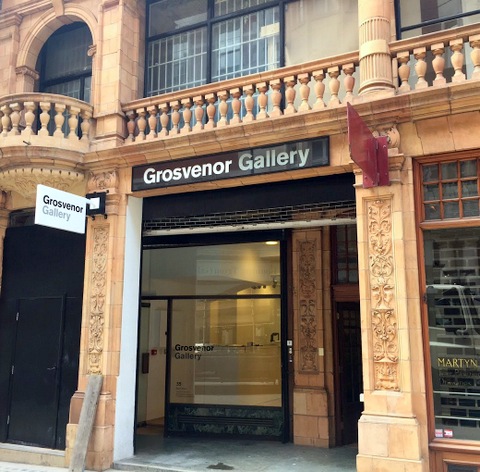GROSVENOR GALLERY
1] The Grosvenor Gallery was established in Bond Street, London in 1877, the brainchild of Sir Coutts Lindsay, 2nd Bart. (1824-1913) and his first wife, who married in 1864, Caroline Blanche Elizabeth née Fitzroy (1844-1912) and it was her money which made the whole enterprise possible. The first directors in 1877 included Joseph William Comyns Carr (1849–1916) and Charles Edward Hallé (1846–1914) and initially, the gallery was a remarkable success both critically and financially, it promoted the works of the Pre-Raphaelite artists including Edward Coley Burne-Jones (1833–1898), William Holman Hunt (1827–1910) and John Everett Millais (1829–1896) and of the Aesthetic Movement in general. James Whistler’s infamous ‘Nocturne in Black and Gold: The Falling Rocket’ which led to the famous libel case between Ruskin and the artist, was also shown at the Grosvenor. In 1888, after a disagreement with Coutts Lindsay, Comyns Carr and Hallé resigned from the gallery and founded a rival New Gallery, capturing Burne-Jones and many of the Grosvenor Gallery's other artists. The break-up of his marriage, financial constraints and personal conflicts forced Lindsay out of the gallery, which was taken over by his estranged wife, but the gallery declined, and it closed in 1890.
2] In October 1912, Colnaghi and Knoedler opened a new Grosvenor Gallery at 51a New Bond Street in the heart of London's fashionable art district, appointing the American-born artist and critic Francis Howard (1874-1954), who worked for Knoedler, as the managing director. The most innovative show staged there was opened in May 1921 and entitled the 'Nameless Exhibition of Modern British Painting'. The exhibited works were gathered and hung by Henry Tonks (1862-1937), Charles Henry Sims (1873-1928) and Roger Eliot Fry (1866-1934) and neither the names nor prices were listed in the accompanying catalogue. This innovative show was sponsored by The Burlington Magazine and contained works by Walter Richard Sickert (1860-1942), Stanley Spencer (1891-1959) and Vanessa Bell (1879-1961). In January 1920 the 'Daily Mirror' announced that the gallery was due to be shut due to problems with funding, but the gallery was reopened in February 1921, under the sole proprietorship of Colnaghi, with an exhibition of living artists. However, it finally closed in 1924. Suffolk artists who exhibited with the [second] Grosvenor Gallery include Nellie Eaton.
3] The Grosvenor was reincarnated in the 1960's and originally located in Davies Street, Mayfair under the auspices of dealer and collector Eric Estorick (1913-1993). It focused on 20th century paintings, sculpture, and drawings. The Grosvenor places a strong emphasis on the works of sculptors such as William Kenneth Armitage (1916-2002), Michael Ayrton (1921-1975), Reginald Cotterell Butler (1913-1981), Lynn Russell Chadwick (1914-2003), Elisabeth Jean Frink, Frederick Edward McWilliam (1909-1992), Bernard William Meadows (1915-2005), Henry Spencer Moore (1898-1986), and Eduardo Paolozzi. Artists include Stanley William Hayter (1901-1988), Grace Henry (1868-1953), Victor Newsome (1935-2018), Kurt Hermann Eduard Karl Julius Schwitters (1887-1948), Mark Shields (1963-) and Karl Weschke (1925-2005). In the 1990s the gallery relocated to Albemarle Street and in 2000 to Ryder Street and in 2024 was at 35 Bury Street.
In 2006, Grosvenor Gallery collaborated with Vadehra Art Gallery in New Delhi to form Grosvenor Vadehra. The purpose of this collaboration was to promote international art in India and Indian art in the UK. It has held international exhibitions in India including a Pablo Picasso exhibition in 2006 and a highly acclaimed exhibition in 2007 of Lucian Freud and Francis Bacon (1909-1992) along with Tyeb Mehta (1925–2009) and Francis Newton Souza (1924-2002).
Website: https://www.grosvenorgallery.com
Works by This Artist

|
Grosvenor Gallery, 33 Bury Street |